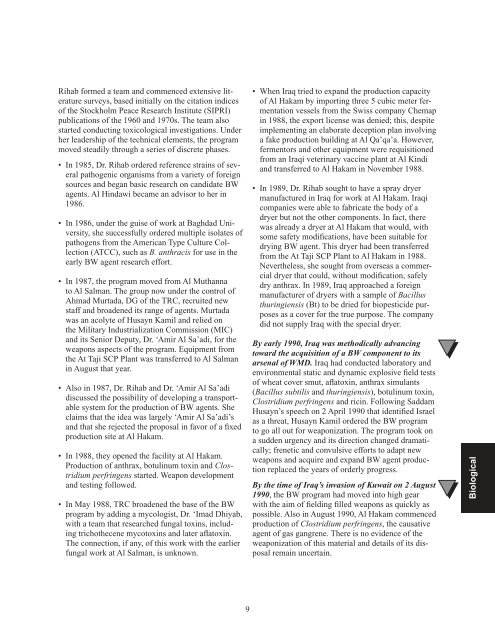Comprehensive Report
GPO-DUELFERREPORT-3
GPO-DUELFERREPORT-3
- No tags were found...
You also want an ePaper? Increase the reach of your titles
YUMPU automatically turns print PDFs into web optimized ePapers that Google loves.
Rihab formed a team and commenced extensive literature<br />
surveys, based initially on the citation indices<br />
of the Stockholm Peace Research Institute (SIPRI)<br />
publications of the 1960 and 1970s. The team also<br />
started conducting toxicological investigations. Under<br />
her leadership of the technical elements, the program<br />
moved steadily through a series of discrete phases.<br />
• In 1985, Dr. Rihab ordered reference strains of several<br />
pathogenic organisms from a variety of foreign<br />
sources and began basic research on candidate BW<br />
agents. Al Hindawi became an advisor to her in<br />
1986.<br />
• In 1986, under the guise of work at Baghdad University,<br />
she successfully ordered multiple isolates of<br />
pathogens from the American Type Culture Collection<br />
(ATCC), such as B. anthracis for use in the<br />
early BW agent research effort.<br />
• In 1987, the program moved from Al Muthanna<br />
to Al Salman. The group now under the control of<br />
Ahmad Murtada, DG of the TRC, recruited new<br />
staff and broadened its range of agents. Murtada<br />
was an acolyte of Husayn Kamil and relied on<br />
the Military Industrialization Commission (MIC)<br />
and its Senior Deputy, Dr. ‘Amir Al Sa’adi, for the<br />
weapons aspects of the program. Equipment from<br />
the At Taji SCP Plant was transferred to Al Salman<br />
in August that year.<br />
• Also in 1987, Dr. Rihab and Dr. ‘Amir Al Sa’adi<br />
discussed the possibility of developing a transportable<br />
system for the production of BW agents. She<br />
claims that the idea was largely ‘Amir Al Sa’adi’s<br />
and that she rejected the proposal in favor of a fixed<br />
production site at Al Hakam.<br />
• In 1988, they opened the facility at Al Hakam.<br />
Production of anthrax, botulinum toxin and Clostridium<br />
perfringens started. Weapon development<br />
and testing followed.<br />
• In May 1988, TRC broadened the base of the BW<br />
program by adding a mycologist, Dr. ‘Imad Dhiyab,<br />
with a team that researched fungal toxins, including<br />
trichothecene mycotoxins and later aflatoxin.<br />
The connection, if any, of this work with the earlier<br />
fungal work at Al Salman, is unknown.<br />
• When Iraq tried to expand the production capacity<br />
of Al Hakam by importing three 5 cubic meter fermentation<br />
vessels from the Swiss company Chemap<br />
in 1988, the export license was denied; this, despite<br />
implementing an elaborate deception plan involving<br />
a fake production building at Al Qa’qa’a. However,<br />
fermentors and other equipment were requisitioned<br />
from an Iraqi veterinary vaccine plant at Al Kindi<br />
and transferred to Al Hakam in November 1988.<br />
• In 1989, Dr. Rihab sought to have a spray dryer<br />
manufactured in Iraq for work at Al Hakam. Iraqi<br />
companies were able to fabricate the body of a<br />
dryer but not the other components. In fact, there<br />
was already a dryer at Al Hakam that would, with<br />
some safety modifications, have been suitable for<br />
drying BW agent. This dryer had been transferred<br />
from the At Taji SCP Plant to Al Hakam in 1988.<br />
Nevertheless, she sought from overseas a commercial<br />
dryer that could, without modification, safely<br />
dry anthrax. In 1989, Iraq approached a foreign<br />
manufacturer of dryers with a sample of Bacillus<br />
thuringiensis (Bt) to be dried for biopesticide purposes<br />
as a cover for the true purpose. The company<br />
did not supply Iraq with the special dryer.<br />
By early 1990, Iraq was methodically advancing<br />
toward the acquisition of a BW component to its<br />
arsenal of WMD. Iraq had conducted laboratory and<br />
environmental static and dynamic explosive field tests<br />
of wheat cover smut, aflatoxin, anthrax simulants<br />
(Bacillus subtilis and thuringiensis), botulinum toxin,<br />
Clostridium perfringens and ricin. Following Saddam<br />
Husayn’s speech on 2 April 1990 that identified Israel<br />
as a threat, Husayn Kamil ordered the BW program<br />
to go all out for weaponization. The program took on<br />
a sudden urgency and its direction changed dramatically;<br />
frenetic and convulsive efforts to adapt new<br />
weapons and acquire and expand BW agent production<br />
replaced the years of orderly progress.<br />
By the time of Iraq’s invasion of Kuwait on 2 August<br />
1990, the BW program had moved into high gear<br />
with the aim of fielding filled weapons as quickly as<br />
possible. Also in August 1990, Al Hakam commenced<br />
production of Clostridium perfringens, the causative<br />
agent of gas gangrene. There is no evidence of the<br />
weaponization of this material and details of its disposal<br />
remain uncertain.<br />
Biological<br />
9


